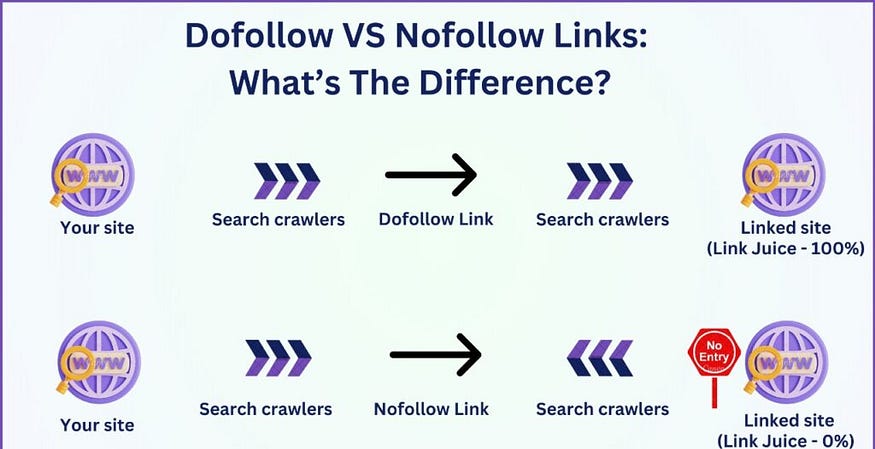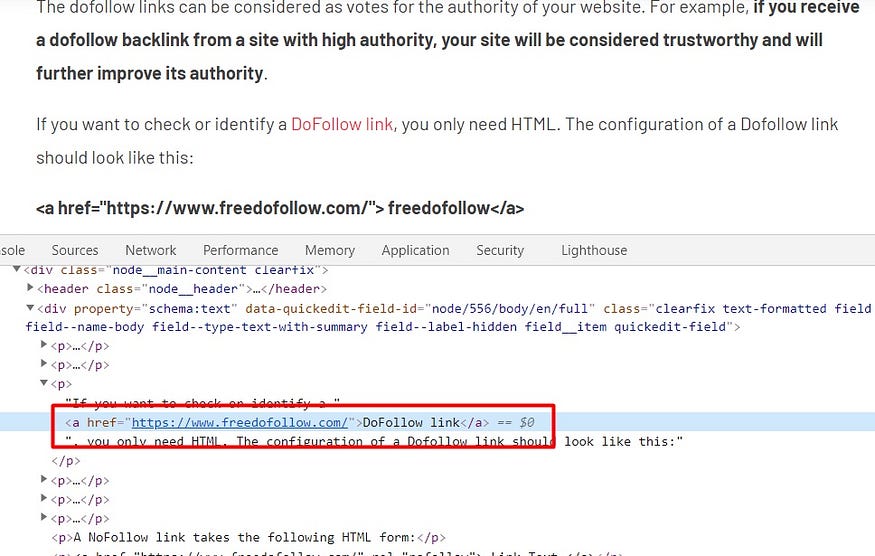Do-Follow vs. No-Follow Links: What’s the Difference?
Imagine the internet as a gigantic web, where each page is connected to another with threads called hyperlinks. These links aren’t just there for navigation they’re crucial in telling search engines what content is valuable, trustworthy, and authoritative. Every link pointing to a page is seen as a “vote of confidence.” The more votes (links) your page has from reputable sources, the higher your chances of ranking better on Google.
Search engines like Google crawl billions of pages daily, using links to find new content and determine its importance. These links can either enhance your visibility in search results or be ignored completely, depending on how they’re set up. That’s where the concepts of Do-Follow and No-Follow links come into play.

Not all links are treated equally. Some links pass on SEO value commonly known as “link juice”while others don’t. This distinction dramatically impacts how your website performs in search rankings and how your link-building strategy should be structured. Whether you’re trying to climb the SEO ladder or maintain a balanced backlink profile, understanding this difference is critical.
What Are Link Attributes?
Link attributes are small pieces of code that you attach to HTML anchor tags. They help search engines understand how they should treat specific links. You might see something like this:
html
CopyEdit
<a href=”https://example.com” rel=”nofollow”>Click Here</a>
In the example above, the rel=”nofollow” attribute tells search engines not to pass any ranking value through that link. On the flip side, if you omit the rel attribute or use rel=”dofollow”, you’re telling Google: “Hey, I trust this link — give it SEO credit.”
Link attributes help webmasters manage SEO impact, prevent spam, and control which pages gain authority. Introduced in 2005, the rel=”nofollow” attribute was designed as a tool to combat comment spam, but its role has evolved significantly over the years.
What is a Do-Follow Link?
Definition and Purpose
A Do-Follow link is the default link type in HTML. When you create a hyperlink without adding any special attributes, it’s automatically considered a do-follow. These links allow search engines to follow them and pass link equity or “link juice” to the target page. In other words, do-follow links help boost the SEO of the page being linked to.

Here’s how a do-follow link looks in HTML:
html
CopyEdit
<a href=”https://example.com”>Visit Example</a>
There’s no need to include rel=”dofollow” because that’s the default behavior. This kind of link is like saying, “I vouch for this page. It’s relevant and valuable to my content.”
Do-follow links are the currency of the SEO world. They’re what most marketers and bloggers chase after when building backlinks because they carry SEO weight.
SEO Impact of Do-Follow Links
Do-follow links can dramatically improve your website’s search engine rankings. Why? Because they transfer domain authority from the linking site to yours. If a high-authority website links to your page, Google sees it as a sign of trust and may reward your site with higher rankings.
This link juice helps search engines determine the relevance and trustworthiness of your content. It also:
- Increases your domain authority (DA)
- Improves your page authority (PA)
- Drives organic traffic from search engines
- Enhances your website’s credibility
The quality of the linking domain plays a major role. A do-follow link from Forbes or TechCrunch is far more valuable than a do-follow link from a random blog with low traffic.
When to Use Do-Follow Links
You should use do-follow links when:
- Linking to high-quality, relevant resources
- Recommending tools, blogs, or guides you trust
- Creating internal links between pages on your own site
Be cautious, though. Too many do-follow links to low-quality sites can harm your SEO. Google could interpret it as spammy behavior, which may negatively impact your site’s ranking.
Use do-follow links strategically to reward trustworthy, authoritative sources and improve the SEO structure of your own website.
What is a No-Follow Link?
Definition and Purpose
A No-Follow link is a type of hyperlink that tells search engines not to follow the link or pass any link equity to the destination URL. It’s basically a way of saying, “I’m linking to this page, but I don’t want to endorse it or share any of my SEO value with it.”
The HTML code looks like this:
html
CopyEdit
<a href=”https://example.com” rel=”nofollow”>Visit Example</a>
By adding rel=”nofollow”, you’re instructing search engines not to consider that link when calculating page rankings. Users can still click on it and visit the page, but from an SEO perspective, it’s neutral.
Why No-Follow Was Introduced
Google introduced the no-follow attribute in 2005 to combat spam, especially in blog comments, forums, and user-generated content. Before that, spammers would flood comment sections with links to their sites in hopes of improving their SEO rankings.
No-follow helped webmasters protect their websites from passing authority to untrustworthy or irrelevant content. Over time, it became a best practice for:
- Paid links and advertisements
- Affiliate links
- Sponsored posts
- User-generated content
- External links that you don’t fully trust
SEO Relevance of No-Follow Links Today
Although no-follow links don’t pass traditional link juice, they’re far from useless. Google has evolved in how it interprets these links. Since 2019, it treats no-follow as a “hint” rather than a strict directive. This means it might still consider the link when assessing content quality and page authority.
No-follow links still:
- Drive referral traffic
- Help with brand visibility
- Diversify your backlink profile
- Indirectly support SEO through engagement signals
In other words, while no-follow links don’t pack the same SEO punch as do-follow links, they’re an essential part of a healthy link strategy.
SEO Benefits of Do-Follow vs. No-Follow
Link Juice Explained
In the SEO universe, “link juice” is a term we use to describe the authority or ranking power passed from one page to another via hyperlinks. Do-follow links are the main carriers of this magical juice. When a website with high authority links to yours using a do-follow link, some of its credibility flows into your site. It’s like getting an endorsement from a respected figure in your niche.
But what about no-follow links? Technically, they don’t pass link juice. However, they still hold value. They might not give you the raw SEO power of a do-follow link, but they can:
- Bring in high-quality traffic
- Boost brand recognition
- Increase engagement on your site
- Provide a natural link profile (which search engines love)
Search engines are now smart enough to look beyond the do-follow/no-follow distinction and assess how links fit within the context of the content. So, even if a no-follow link doesn’t directly boost your rankings, it can still help your site grow in authority and visibility over time.
Backlink Profile Building
Your backlink profile is a collection of all the links pointing to your site. Search engines don’t just look at the number of links — they look at the diversity, relevance, and trustworthiness of those links too. Having only do-follow links might look suspicious, almost like you’re trying to game the system. That’s where no-follow links come in.
A natural backlink profile includes both types of links. Here’s why:
- It mimics organic linking behavior across the web
- It reduces the risk of getting flagged for spammy practices
- It shows that your site earns mentions in various contexts
Smart SEOs aim for a balanced backlink strategy. They pursue do-follow links for the juice, but they also welcome no-follow links for credibility, traffic, and safety.
Balancing Your Link Strategy
If you’re chasing only do-follow links, you’re doing it wrong. A smart link strategy involves using both:
- Do-follow for building SEO authority
- No-follow for maintaining a safe and natural profile
Here’s how to balance it:
- Create high-quality content that naturally earns both types
- Participate in forums, comment sections, and communities (usually no-follow)
- Collaborate with influencers and bloggers (aim for mixed links)
- Share your content on social platforms (mostly no-follow but high traffic)
Search engines appreciate authenticity. When they see a site getting a mix of mentions from different sources, they trust it more.
To Know more about Do-Follow vs. No-Follow Links read our article now



Comments
Post a Comment